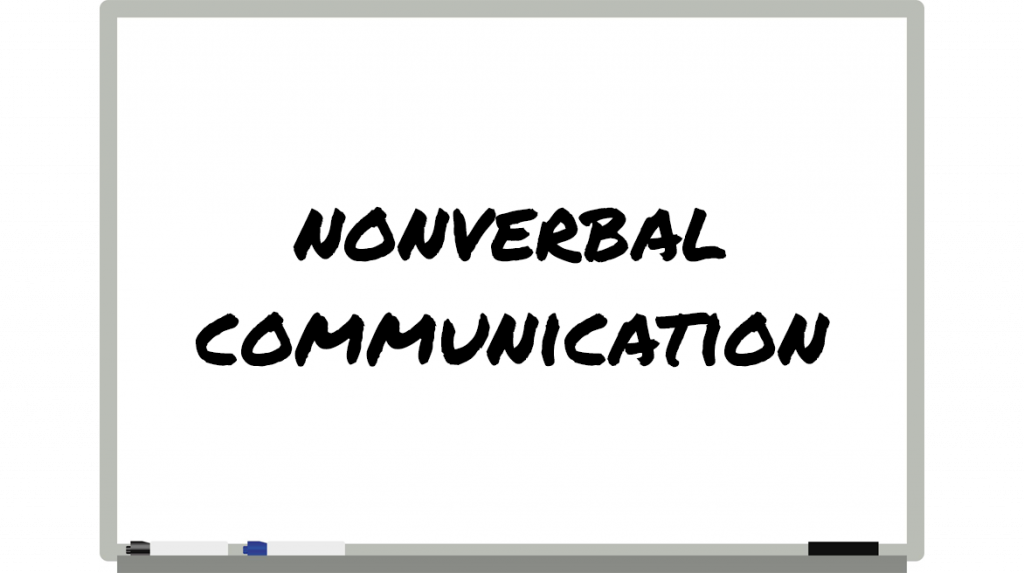In this post, we’ll unpack all you need to know about Nonverbal Communication, defining exactly what it is, the power of it, 8 of the most important Nonverbal Communication behaviours and more.
What Is Nonverbal Communication?
Nonverbal Communication (NC) refers to communication that does not involve words. This includes eye contact, facial expressions, gestures, touch, movement, posture and space. It is an external reflection of our internal state.
Studies reveal that 93% of how we communicate is non-verbal, made up of body language (55%) and tone of voice (38%) while it can constitute 100% of communication between two partners during sex. Actions truly speaks louder than words.
The Power Of Nonverbal Communication
The ability to read and interpret nonverbal signals as a way to decode a person’s true thoughts, feelings and intentions was the original communication system used by humans before spoken language evolved.
In today’s society, communication remains integral to building relationships ― and relationships are central to finding success. In fact, research shows those who can effectively read and interpret nonverbal communication and manage how others perceive them enjoy greater success in life than those who lack this skill.
Therefore, learning how to decipher nonverbal cues and signals will give you an important edge. Not only will you be better able to read the messages that others send to you, but you’ll be better rehearsed in the messages you send to others, allowing you to more effectively achieve your objectives.
8 Of The Most Important Nonverbal Behaviours
One of the best things about gaining an understanding of nonverbal communication is its universal applicability.
For example, when we experience a sense of comfort, this is reflected in the form of universal body language that is congruent with our positive feelings. Similarly, when we experience a sense of discomfort, this is reflected in the form of universal body language that is congruent with our negative feelings.
There are 8 major nonverbal behaviours. They are:
- Mirror & Matching
- Head Movements
- Eye Contact
- Arms
- Hands
- Handshakes
- Posture
- Touch
Below we’ll unpack each behaviour in more detail. It is important to remember that when evaluating other people, never interpret a gesture in isolation, always look for clusters of at least three behaviours that represent a specific state.
- Mirroring & Matching
Mirroring and matching involves modelling someone’s behaviours, including breathing pattern, posture, gestures, language, volume and speed of speech and tone of voice.
Mirroring and matching helps build trust and establish rapport. It works because we like people who are like us. This makes sense because in prehistoric times, modelling the behaviour of others was used as a social device to help us successfully fit into large groups.
A study conducted by psychologist Richard Wiseman used waiters to identify what method was more effective at creating a connection with strangers; mirroring or positive reinforcement.
The first group of waiters used positive reinforcement by lavishing praise and encouragement on their customers, using words such as “great,” “no problem” and “sure” in response to each order. The second group of waiters mirrored their customers simply by repeating their orders back to them.
Incredibly, the waiters who mirrored their customers earned 70% more tips than those who used positive reinforcement.
Breathing is the single most important component of physiology to work with when matching and mirroring because it is unconscious in the other person and the easiest to notice. Watch the shoulders, the chest and the stomach.
- Head Movements
Since body language is an unconscious outward reflection of inner feelings, head movements are a great way to identify whether what someone is saying is congruent with their inner state.
For example, if the speaker answers either “Yes” or “No” to a question, how they motion their head ― either nodding it which is congruent with “Yes” or shaking it which is congruent with “No” ― will help determine whether they are being truthful or deceitful.
Head nodding is an excellent tool for building rapport, getting agreement and encouraging cooperation. In fact, research shows that people will talk three to four times more when the listener nods their head using groups of three nods at regular intervals.
The speed that a person nods communicates their level of patience of the listener. Slow nodding communicates that the listener is interested in what the speaker is saying. Fast nodding communicates that the listener has had enough of what the speaker is saying.
- Eye Contact
Since vision is our most dominant sense, eye contact is one of the most important types of nonverbal communication. The way you look at someone can communicate many things.
From an evolutionary perspective, eye contact was a signal for us either to advance or retreat.
Strong eye contact signals confidence, authority and sincerity. Weak eye contact signals insecurity, doubt and insincerity, particularly if someone is looking down at the ground.
Eye contact also produces oxytocin ― a hormone associated with trust ― in both the speaker and the listener. This is why when we like someone, we tend to look at them more.
Research shows that to build rapport with another person, you should hold eye contact 60-70% of the time. This is especially important during the first few seconds of making eye contact not to look away.
- Arms
Our arms are like shields which can serve to create a barrier separating us from the outside world. Arms folded tends to signal a negative attitude. Arms unfolded tends to signal a positive attitude.
If you find yourself interacting with someone who has their arms crossed, a simple but effective strategy that you can use to encourage them to uncross their arms and adopt a more open and positive attitude is to give them something to hold or something to do. The more open they are physically, the more engaged and open they will be mentally.
In one study involving students, those who were instructed to keep their arms folded during a series of lectures had learned and retained 38% less than those were instructed to keep their arms unfolded.
- Hands
In comparison to all other species, human hands are unique. They can manipulate objects and instruments to a far greater degree of precision compared to other primates and animals by gripping, grasping and forming precise movements. However, human hands are not just unique in what they do, but also in what they say.
In prehistoric times, whenever primitive tribes met under friendly conditions, they would hold their arms out with their palms exposed to show that no weapons were being held or concealed, communicating the message: We come in peace!
In today’s world, hands are just as important for revealing someone’s intention. Hands that are exposed communicates trust, honesty and openness while hands that are hidden is a signal that you may not be trustworthy.
Interestingly, research shows that infants who use more hand gestures at eighteen months old have greater language abilities later on in life. Hand gestures speak to greater intelligence.
- Handshakes
The first time we come in physical contact with someone is usually accompanied by a handshake. It may seem trivial, but get it wrong and it can leave a lasting negative impression, but get it right and it can leave a lasting positive impression.
In one experiment on 150 undergraduate students, researchers tested the correlation between types of handshakes and perceptions of character traits. Firm handshakes were perceived as extroversion and emotional expressiveness. Weak handshakes were perceived as insecurity and shyness. The results concluded that the firmer a handshake is, the more social and confident a person is perceived.
There are three key elements to an effective handshake that will allow you to create rapport. The first is to ensure that both palms are in the vertical position. The second is to apply the same pressure that you receive. The third is to maintain eye contact. Combined, these three elements signal trust, integrity and that you are someone who can be relied on.
Interestingly, studies show that people are twice as likely to remember you if you shake hands with them.
- Posture
When we make ourselves bigger, we communicate that we feel empowered. When we make ourselves smaller, we communicate that we feel disempowered.
Someone who is slumped, with their head down, shoulders forwards, chest caving in and breathing shallow is going to create an entirely different biochemistry compared to someone who is standing upright, with their head up, shoulders back, chest out and breathing deeply.
In fact, studies show that when we expand ourselves, our risk level is 86%, testosterone levels increase by 20% and cortisol levels decrease by 25%. In contrast, when we contract ourselves, our risk level is 60%, testosterone levels decrease by 10% and cortisol levels increase by 15%.
- Touch
Physical contact is essential for the survival of our specials. It communicates a sense of intimacy and signals connection between two people.
Supportive touch stimulates the release of oxytocin in the recipient’s brain and research shows this can have profound effects.
In one study, waitresses who touched their customers got higher tips. A second study showed that petition gatherers who touched people they talked to got more signatures. In yet another study, two psychologists from the University of California, Berkley, analysed ninety televised hours of professional basketball. They found that teams that touched the most (high fives, shoulder bumps etc) won the most amount of games.
In relationships, the amount of physical contact is associated with rapport, trust and level of intimacy between two partners. The more contact, the stronger the relationship is likely to be.
- Pacifying Behaviours
Pacifying behaviours are (usually subconscious) nonverbal behaviours that pacify stress or anxiety. In his book What Every Body Is Saying, body language expert Joe Navarro outlines the following examples of pacifying behaviours:
- Neck touching.
- Face touching.
- Rubbing the forehead.
- Touching clothing accessories.
- Nail biting.
As a general rule, the greater the stress or anxiety, the greater the likelihood of pacifying behaviours that will follow. Pacifying behaviours are a great way to assess for comfort and discomfort as they reveal a lot about our emotional state and how we are truly feeling.
The Green Line Theory
The Green Line Theory is a conceptual framework for understanding relationship dynamics as they relate to the expression and perception of power.
Using this framework, men can optimise their body language in a way that projects strength, confidence and power.
How To Leverage Nonverbal Communication
Nonverbal Communication is the key to success in every area of life.
Thus, the key to leveraging Nonverbal Communication is to communicate in a way that aligns with your goals and the quality of life you desire.
Summary (TL;DR)
Nonverbal communication refers to behavioural elements of human-to-human messages, besides spoken words, including eye contact, facial expressions, gestures, touch, movement, posture and space.
Mastering nonverbal communication will not only allow you to better read and interpret the messages of others, but it will also allow you to communicate more effectively. In turn, this will improve your relationships, enhance your personal interactions and ultimately enrich your life.



